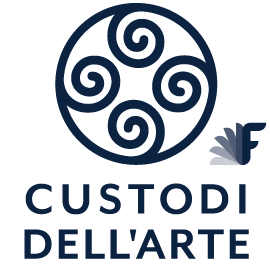

Piazza delle Conserve (Conserve Square)
Piazza delle Conserve (Conserve Square)
Riproduci traccia audio
Play audio track
Audio-Track abspielen
Piazza delle Conserve (Conserve Square)
Trascrizione traccia audio
You will not believe it, but there was a time when as children we didn’t even know that the large pits in this square existed. They were created to keep fish and other foods cool. Nowadays they are a tourist attraction and tell a story of Cesenatico’s past.
In town there were as many as twenty of these pits, they were protected by low buildings and filled with layers of ice or compressed snow that collected in the ditches that run alongside fields out of town. They were built at the start of the seventeenth century, and they fell into disuse in 1930, when the manufacture of ice started.
Then, during the eighties, this square was renovated, and the pits were rediscovered, three of them were restored and the surrounding cobbles were re-laid.
In the period immediately after the war however, instead of these beautiful cobbles, it was a large area of rough ground. On summer mornings a large truck would drive through the area spraying water to keep the dust at bay.
This square was devastated by bombs in the war, people lived in houses without doors and windows, sometimes without even blankets. In winter there was always a lot of snow, and it was very cold, only the lucky few had a stove, but there were also those who kept warm with their pets, like Elvezio and his family with their hundred cats!
Once upon a time there was despair and misery here. In winter no one worked, only the fishermen.
Once the houses didn’t even have toilets, for us who lived here there was only one available, a squat toilet, in the middle of the courtyard, which we shared with the patrons of the Osteria del Gallo, which was my aunt’s restaurant.
On Sundays there was the local market: in the square they sold fruit, vegetables, and clothes; There were also shoe stalls at the back of what was once an anchovy factory.
In summer, at snack time a lady called Beppa would arrive with her wheelbarrow, caramelized pumpkin, and cooked pears. “Children, Children, the pumpkin has arrived!” she would call, in dialect.
I remember that the circus would arrive too, with its lights illuminating the space, and filling the air with the scent of candyfloss, which we could not afford. Usually, however, the smell that dominated the square was that of fish.
As children, in the warm months we always played hide and seek. On summer evenings we enjoyed pulling crickets out of holes in the ground by their claws, we would tie them to a thread and make them fly. Near the anchovy factory there was also a small stretch of sand where we made a track and played with marbles.
On Sundays, the square would be populated by women who played “zun”, a kind of bowling alley with wooden balls and poles made from broomsticks instead of skittles; the poles were graduated, and the winner was the one who scored the most points by overturning them. There was such a festive atmosphere, so much so that some women even put on lipstick.
I was born in the Piazza della Conserve, and I lived here until I was 13 years old and afterwards, I always came back to be together with friends and see the people with their animated lives who animated the square, making it a special place.
I think of Olindo, who sold wine in that yellow house, there at the bottom. To Aeneas, who built cages for birds, and then became a healer. Of Elvezio, who was able to do everything with aluminium and specialised in fixing the plating of the boats.
I think of the sailor nicknamed “Ruca”, who wore clogs in all seasons, summer or winter; he was always hungry and one evening, in the nearby town of Bellaria, for a bet he ate a bunch of gladioli.
And then I see my mum’s grandfather again, who in the summer would sit outside in the yard with a towel on his head to ward off flies. He was a tall man 1.9 meters high, and as a young man had been a diver. I remember the many afternoons when he told me about his dives and how under the sea it was like a garden, “decorated” with different seaweeds and plants.
He once told me that his ship’s captain had lost his wedding ring at sea and had given him orders to dive and go in search of it. My great-grandfather lowered himself into the sea, re-emerging with the ring in his hands. As a reward, the captain sent him home in a four-horse-drawn carriage.
This square is made up of many stories. Stories now invisible just like the pits were for a long time, but also unforgettable for those who, like me, have encountered and lived them.
Audio Track transcription
You will not believe it, but there was a time when as children we didn’t even know that the large pits in this square existed. They were created to keep fish and other foods cool. Nowadays they are a tourist attraction and tell a story of Cesenatico’s past.
In town there were as many as twenty of these pits, they were protected by low buildings and filled with layers of ice or compressed snow that collected in the ditches that run alongside fields out of town. They were built at the start of the seventeenth century, and they fell into disuse in 1930, when the manufacture of ice started.
Then, during the eighties, this square was renovated, and the pits were rediscovered, three of them were restored and the surrounding cobbles were re-laid.
In the period immediately after the war however, instead of these beautiful cobbles, it was a large area of rough ground. On summer mornings a large truck would drive through the area spraying water to keep the dust at bay.
This square was devastated by bombs in the war, people lived in houses without doors and windows, sometimes without even blankets. In winter there was always a lot of snow, and it was very cold, only the lucky few had a stove, but there were also those who kept warm with their pets, like Elvezio and his family with their hundred cats!
Once upon a time there was despair and misery here. In winter no one worked, only the fishermen.
Once the houses didn’t even have toilets, for us who lived here there was only one available, a squat toilet, in the middle of the courtyard, which we shared with the patrons of the Osteria del Gallo, which was my aunt’s restaurant.
On Sundays there was the local market: in the square they sold fruit, vegetables, and clothes; There were also shoe stalls at the back of what was once an anchovy factory.
In summer, at snack time a lady called Beppa would arrive with her wheelbarrow, caramelized pumpkin, and cooked pears. “Children, Children, the pumpkin has arrived!” she would call, in dialect.
I remember that the circus would arrive too, with its lights illuminating the space, and filling the air with the scent of candyfloss, which we could not afford. Usually, however, the smell that dominated the square was that of fish.
As children, in the warm months we always played hide and seek. On summer evenings we enjoyed pulling crickets out of holes in the ground by their claws, we would tie them to a thread and make them fly. Near the anchovy factory there was also a small stretch of sand where we made a track and played with marbles.
On Sundays, the square would be populated by women who played “zun”, a kind of bowling alley with wooden balls and poles made from broomsticks instead of skittles; the poles were graduated, and the winner was the one who scored the most points by overturning them. There was such a festive atmosphere, so much so that some women even put on lipstick.
I was born in the Piazza della Conserve, and I lived here until I was 13 years old and afterwards, I always came back to be together with friends and see the people with their animated lives who animated the square, making it a special place.
I think of Olindo, who sold wine in that yellow house, there at the bottom. To Aeneas, who built cages for birds, and then became a healer. Of Elvezio, who was able to do everything with aluminium and specialised in fixing the plating of the boats.
I think of the sailor nicknamed “Ruca”, who wore clogs in all seasons, summer or winter; he was always hungry and one evening, in the nearby town of Bellaria, for a bet he ate a bunch of gladioli.
And then I see my mum’s grandfather again, who in the summer would sit outside in the yard with a towel on his head to ward off flies. He was a tall man 1.9 meters high, and as a young man had been a diver. I remember the many afternoons when he told me about his dives and how under the sea it was like a garden, “decorated” with different seaweeds and plants.
He once told me that his ship’s captain had lost his wedding ring at sea and had given him orders to dive and go in search of it. My great-grandfather lowered himself into the sea, re-emerging with the ring in his hands. As a reward, the captain sent him home in a four-horse-drawn carriage.
This square is made up of many stories. Stories now invisible just like the pits were for a long time, but also unforgettable for those who, like me, have encountered and lived them.
Audiotrack-Text
You will not believe it, but there was a time when as children we didn’t even know that the large pits in this square existed. They were created to keep fish and other foods cool. Nowadays they are a tourist attraction and tell a story of Cesenatico’s past.
In town there were as many as twenty of these pits, they were protected by low buildings and filled with layers of ice or compressed snow that collected in the ditches that run alongside fields out of town. They were built at the start of the seventeenth century, and they fell into disuse in 1930, when the manufacture of ice started.
Then, during the eighties, this square was renovated, and the pits were rediscovered, three of them were restored and the surrounding cobbles were re-laid.
In the period immediately after the war however, instead of these beautiful cobbles, it was a large area of rough ground. On summer mornings a large truck would drive through the area spraying water to keep the dust at bay.
This square was devastated by bombs in the war, people lived in houses without doors and windows, sometimes without even blankets. In winter there was always a lot of snow, and it was very cold, only the lucky few had a stove, but there were also those who kept warm with their pets, like Elvezio and his family with their hundred cats!
Once upon a time there was despair and misery here. In winter no one worked, only the fishermen.
Once the houses didn’t even have toilets, for us who lived here there was only one available, a squat toilet, in the middle of the courtyard, which we shared with the patrons of the Osteria del Gallo, which was my aunt’s restaurant.
On Sundays there was the local market: in the square they sold fruit, vegetables, and clothes; There were also shoe stalls at the back of what was once an anchovy factory.
In summer, at snack time a lady called Beppa would arrive with her wheelbarrow, caramelized pumpkin, and cooked pears. “Children, Children, the pumpkin has arrived!” she would call, in dialect.
I remember that the circus would arrive too, with its lights illuminating the space, and filling the air with the scent of candyfloss, which we could not afford. Usually, however, the smell that dominated the square was that of fish.
As children, in the warm months we always played hide and seek. On summer evenings we enjoyed pulling crickets out of holes in the ground by their claws, we would tie them to a thread and make them fly. Near the anchovy factory there was also a small stretch of sand where we made a track and played with marbles.
On Sundays, the square would be populated by women who played “zun”, a kind of bowling alley with wooden balls and poles made from broomsticks instead of skittles; the poles were graduated, and the winner was the one who scored the most points by overturning them. There was such a festive atmosphere, so much so that some women even put on lipstick.
I was born in the Piazza della Conserve, and I lived here until I was 13 years old and afterwards, I always came back to be together with friends and see the people with their animated lives who animated the square, making it a special place.
I think of Olindo, who sold wine in that yellow house, there at the bottom. To Aeneas, who built cages for birds, and then became a healer. Of Elvezio, who was able to do everything with aluminium and specialised in fixing the plating of the boats.
I think of the sailor nicknamed “Ruca”, who wore clogs in all seasons, summer or winter; he was always hungry and one evening, in the nearby town of Bellaria, for a bet he ate a bunch of gladioli.
And then I see my mum’s grandfather again, who in the summer would sit outside in the yard with a towel on his head to ward off flies. He was a tall man 1.9 meters high, and as a young man had been a diver. I remember the many afternoons when he told me about his dives and how under the sea it was like a garden, “decorated” with different seaweeds and plants.
He once told me that his ship’s captain had lost his wedding ring at sea and had given him orders to dive and go in search of it. My great-grandfather lowered himself into the sea, re-emerging with the ring in his hands. As a reward, the captain sent him home in a four-horse-drawn carriage.
This square is made up of many stories. Stories now invisible just like the pits were for a long time, but also unforgettable for those who, like me, have encountered and lived them.
Narrato da
Narrated by
Mehr Infos



